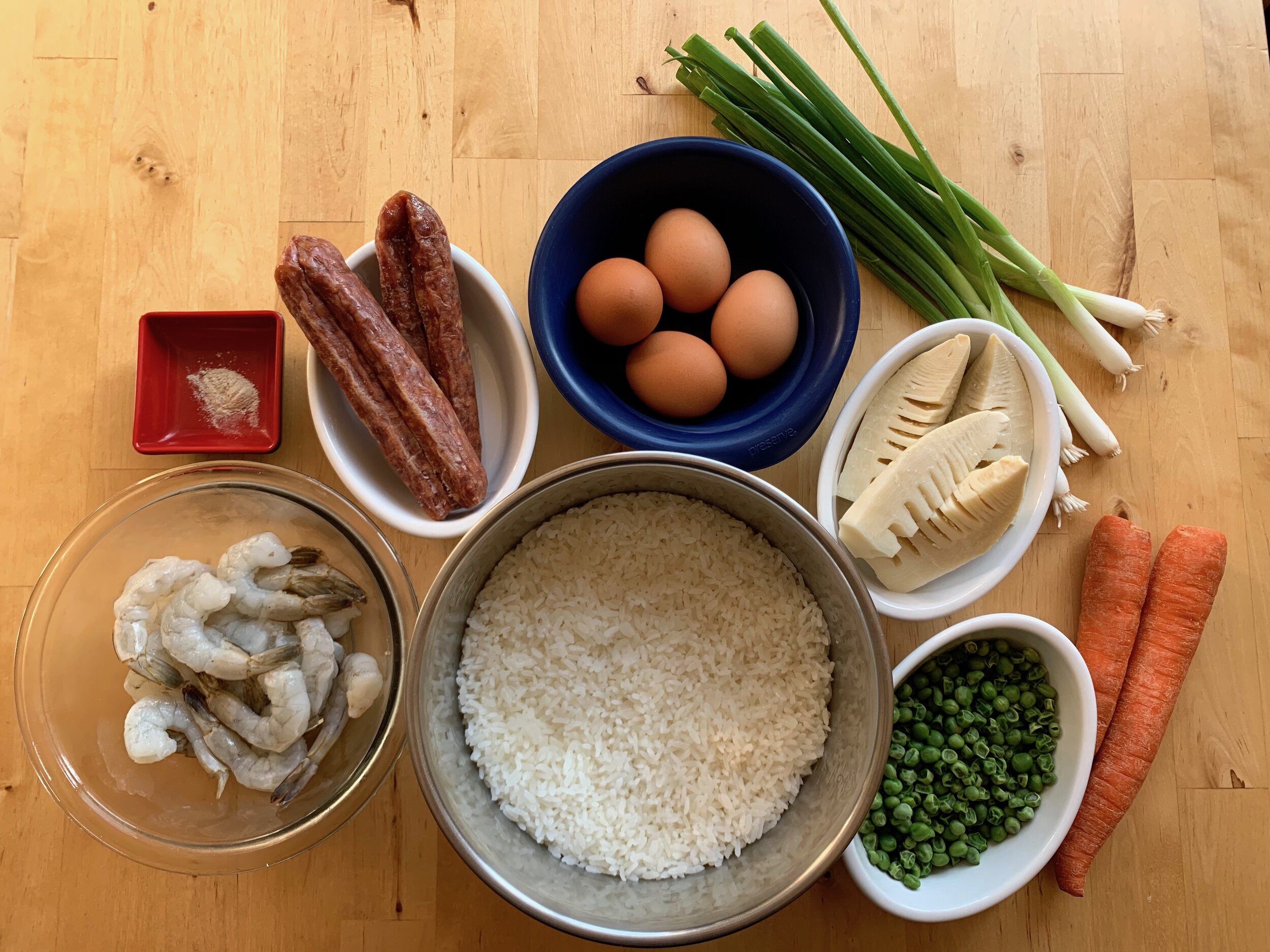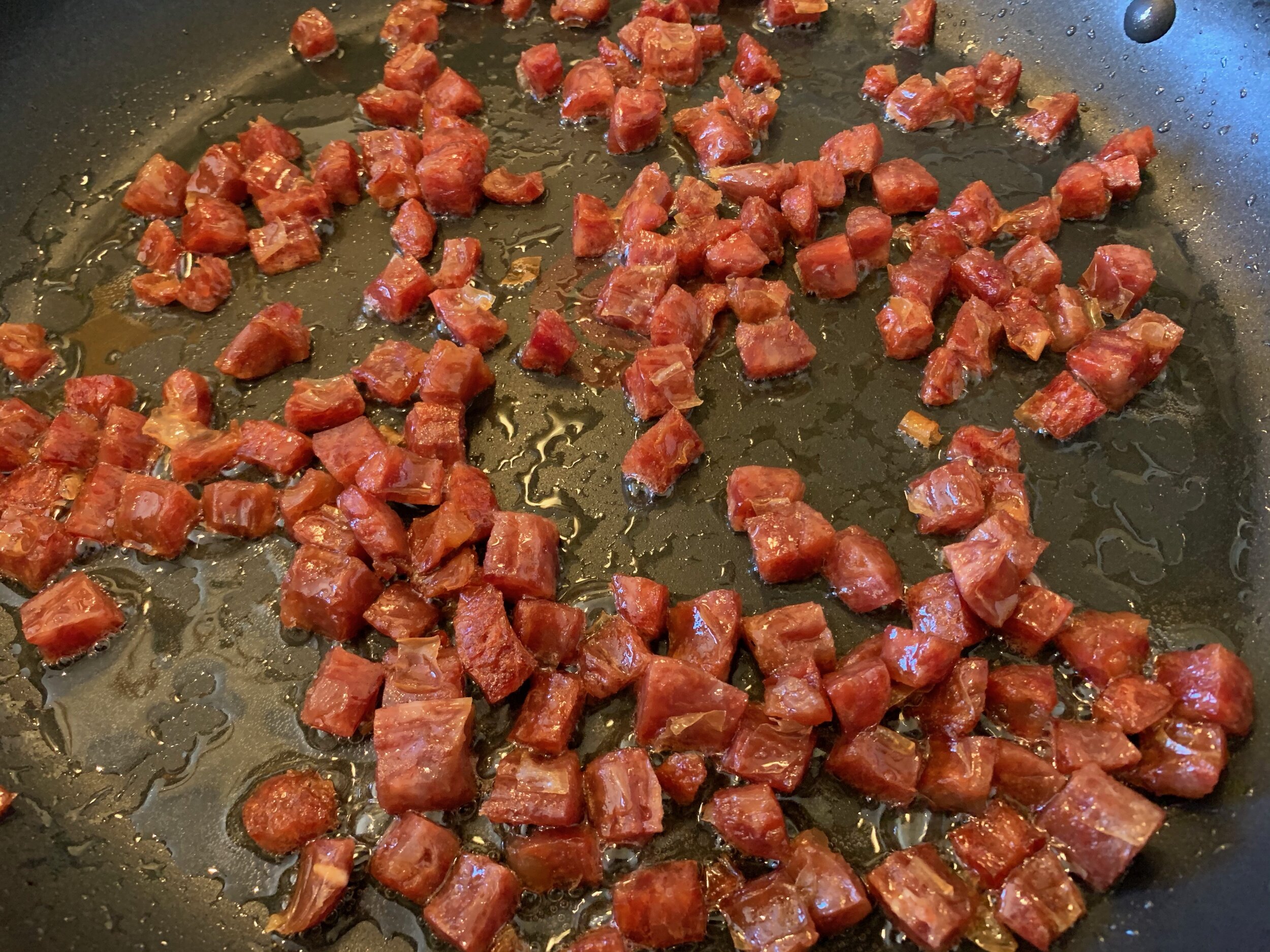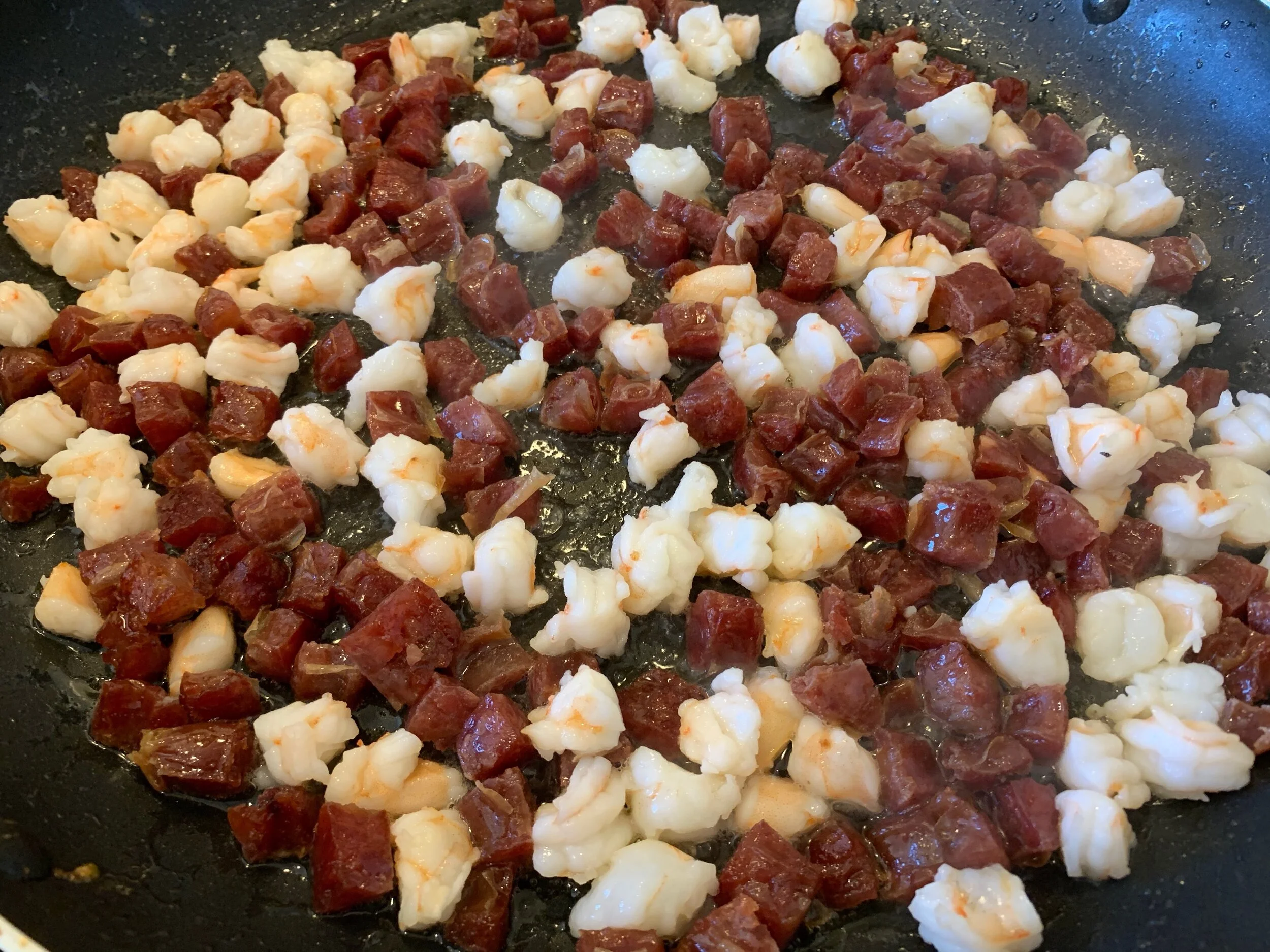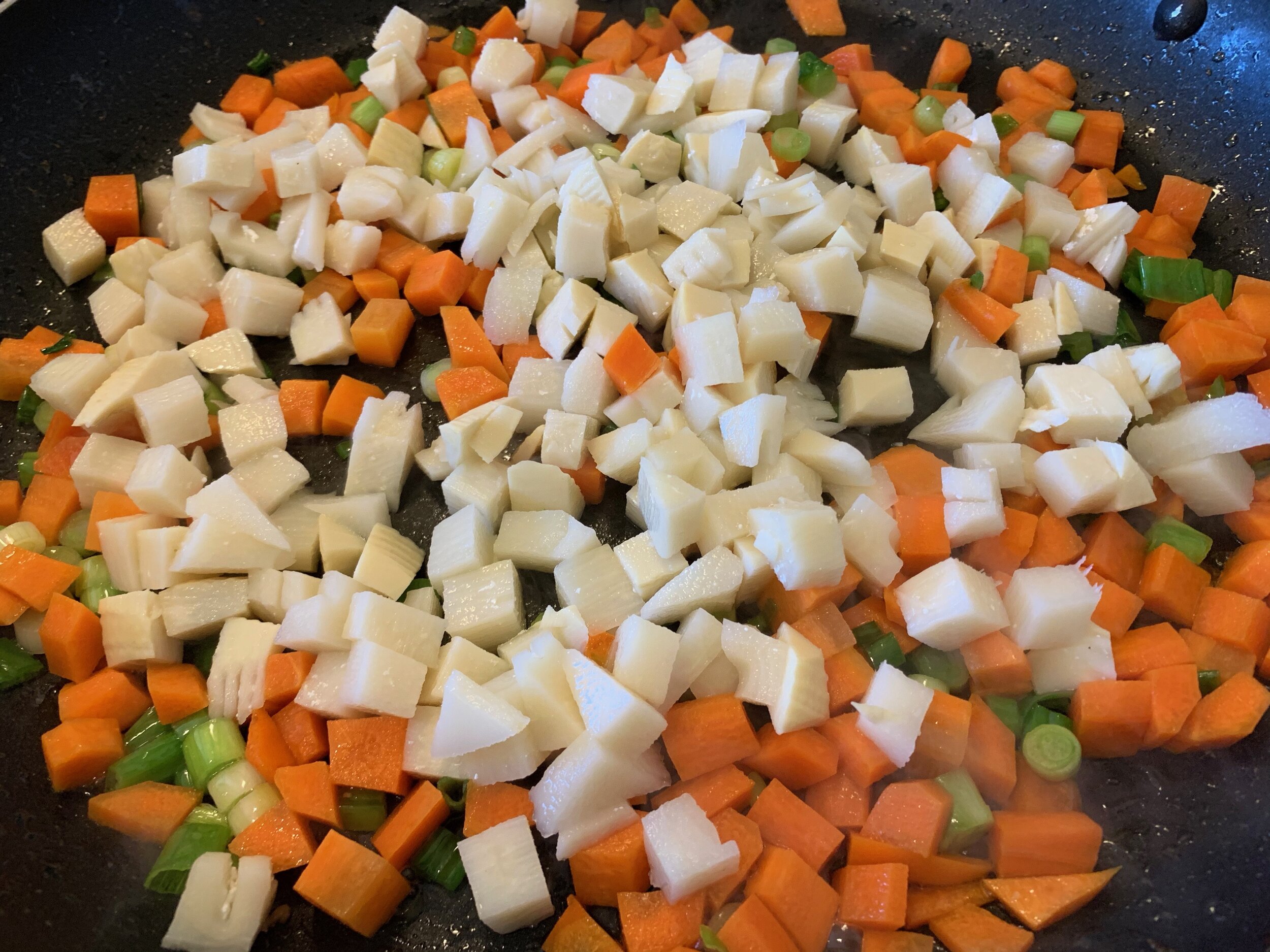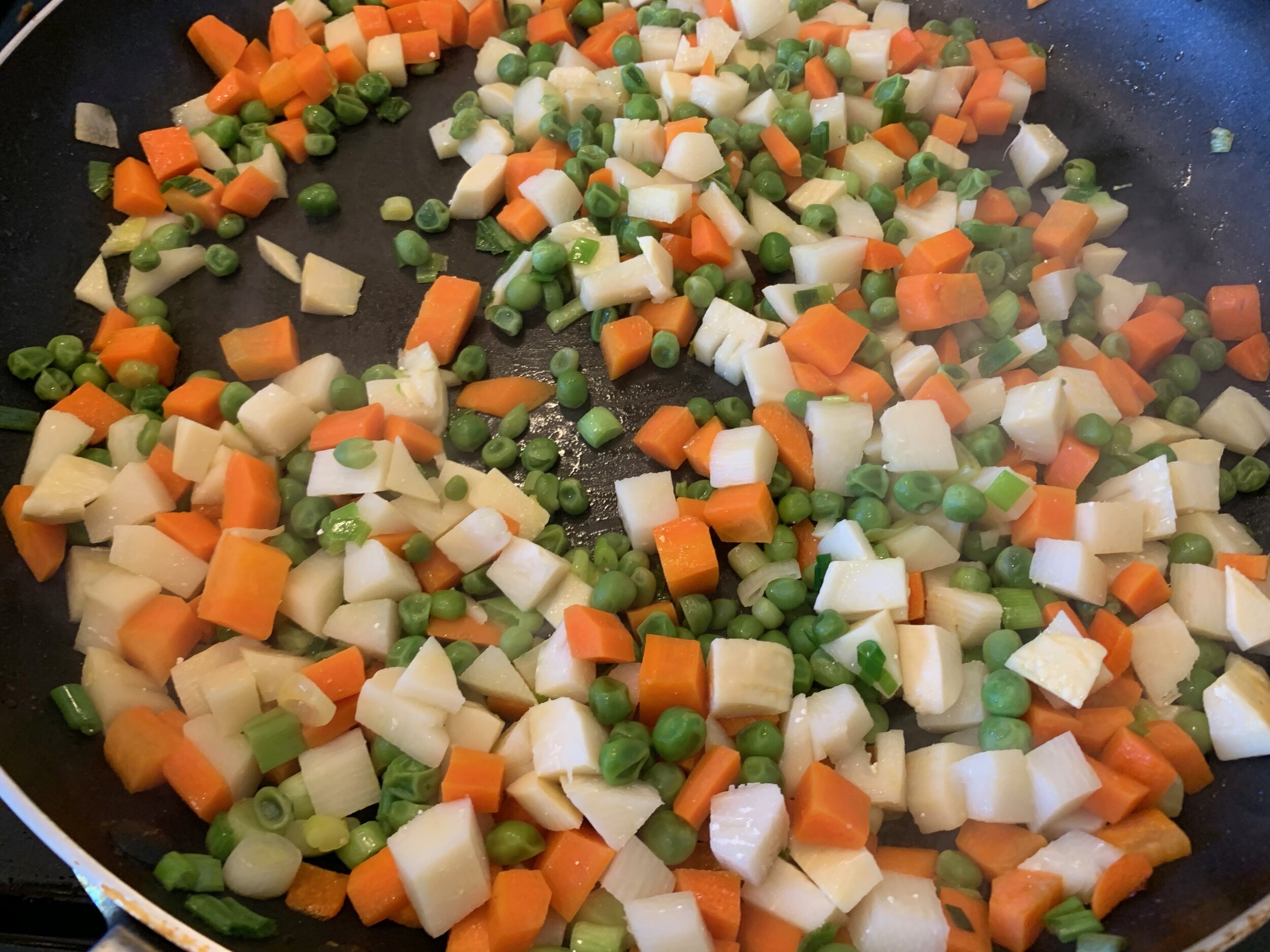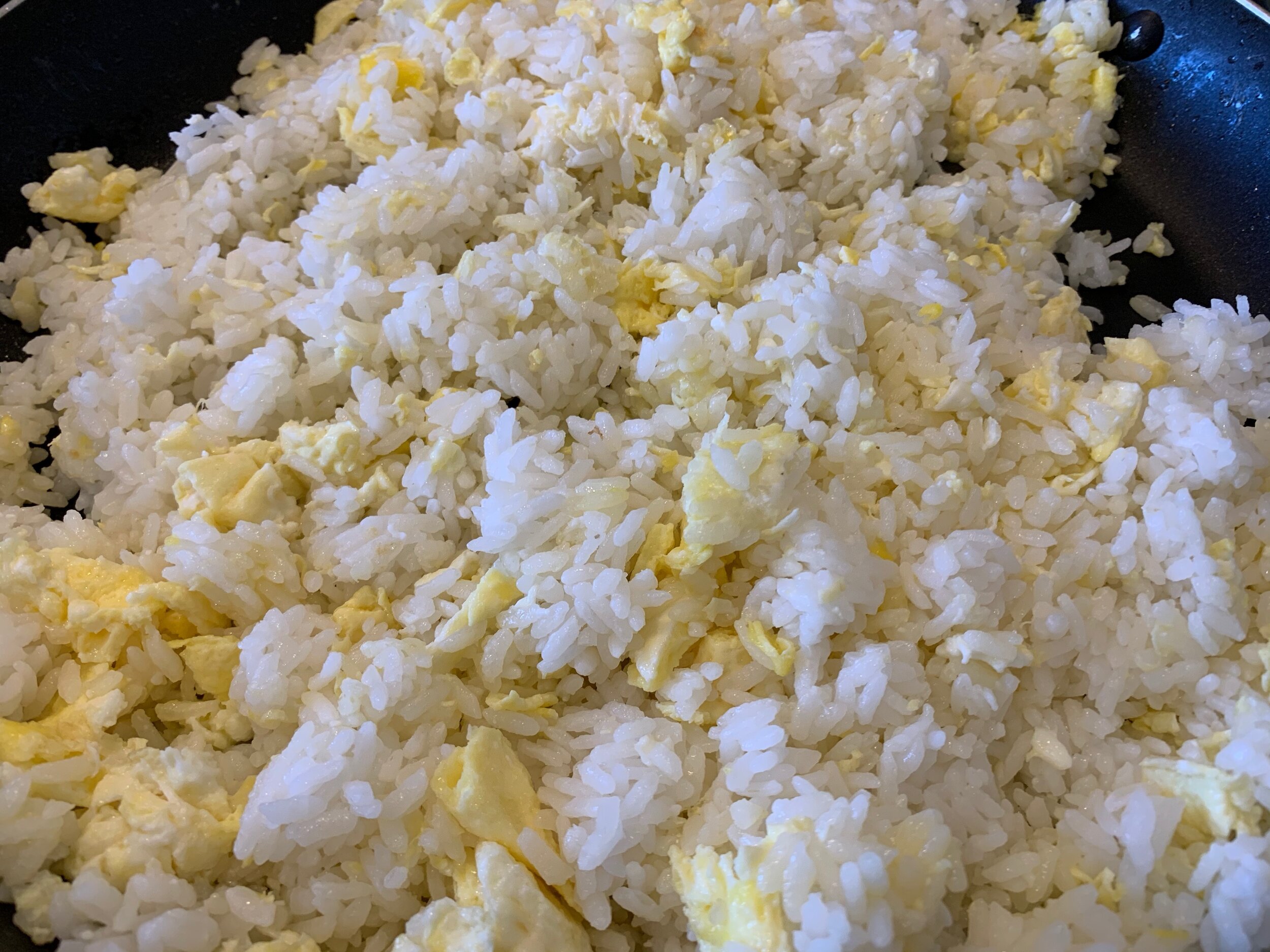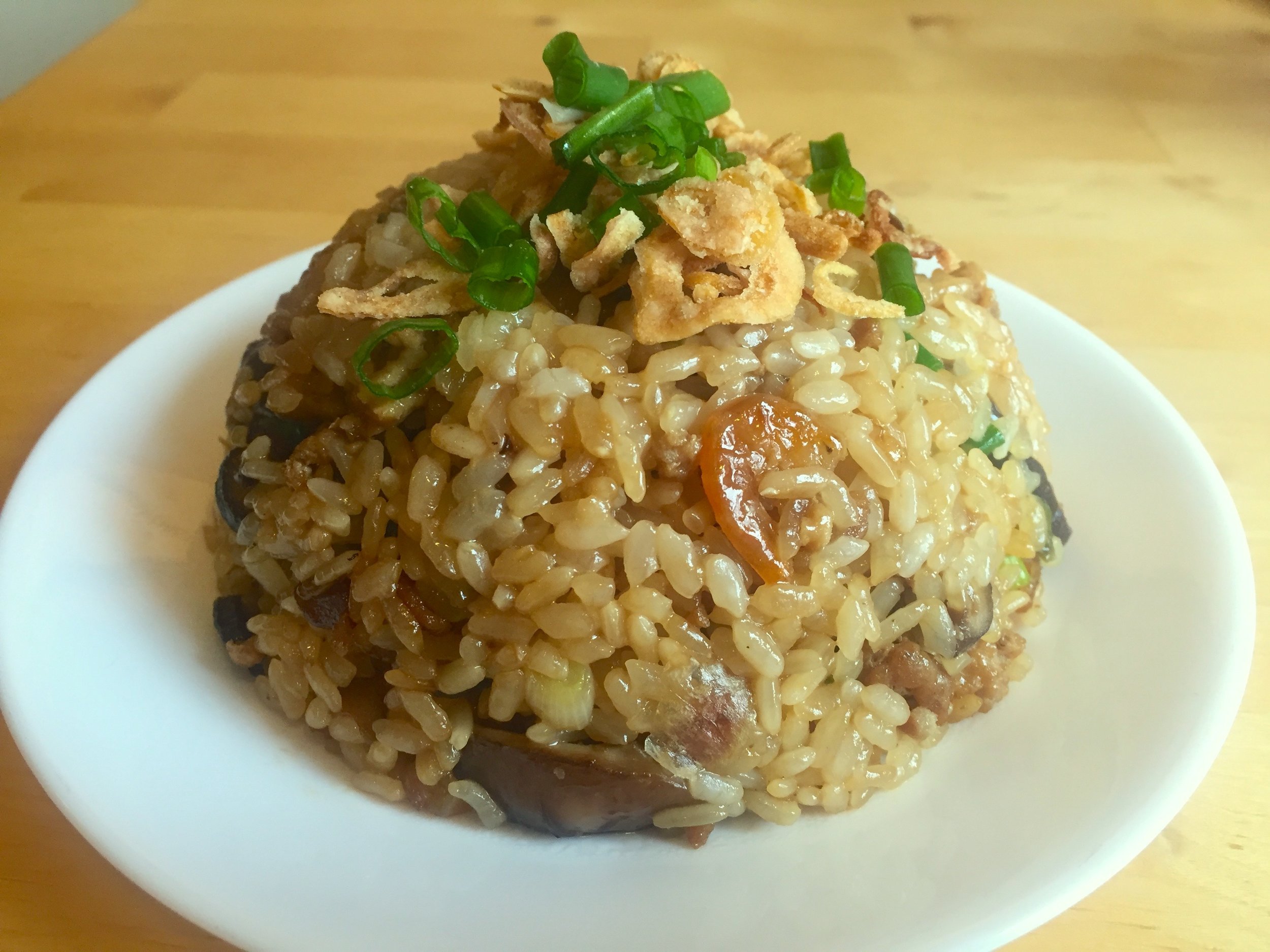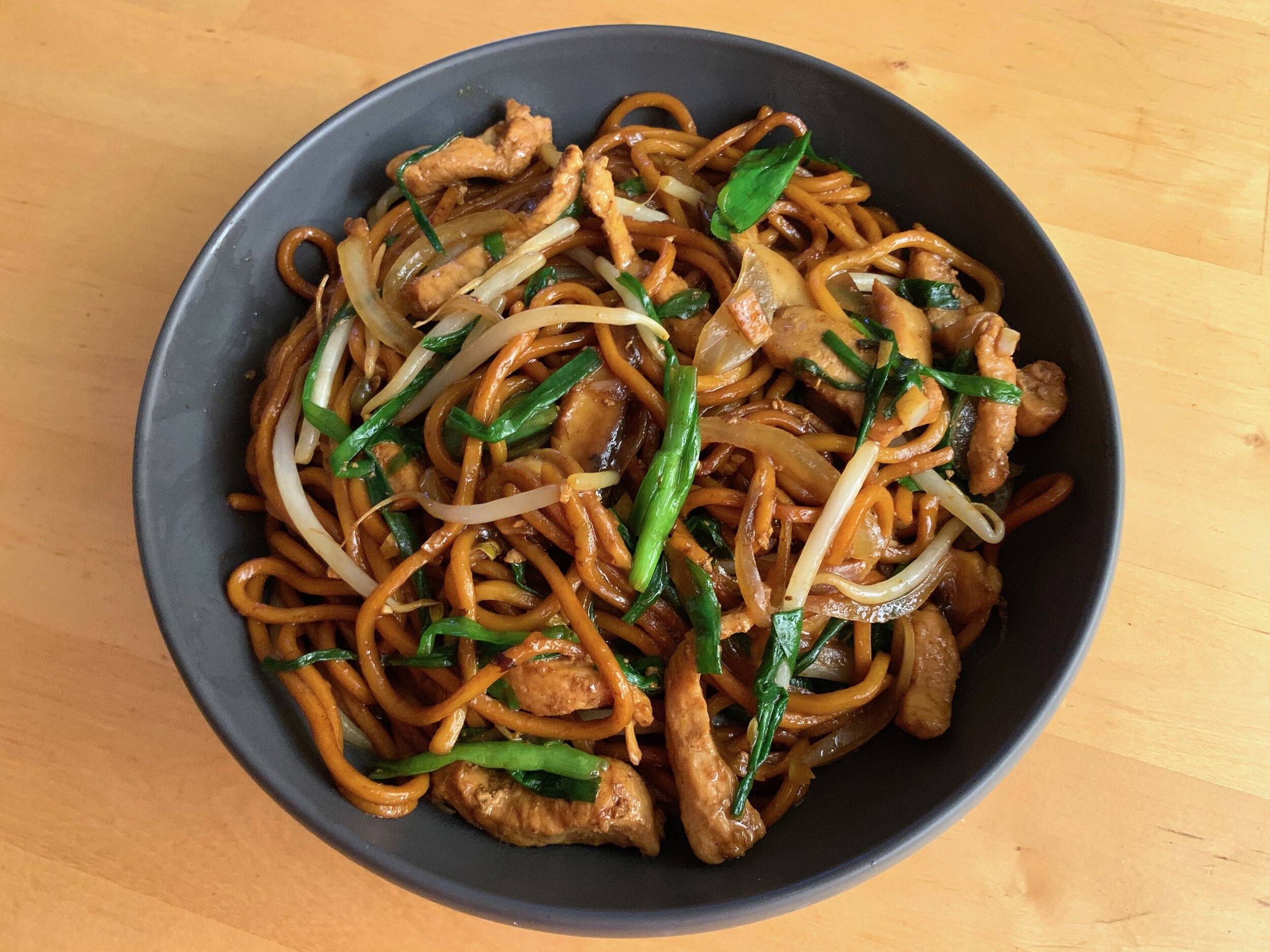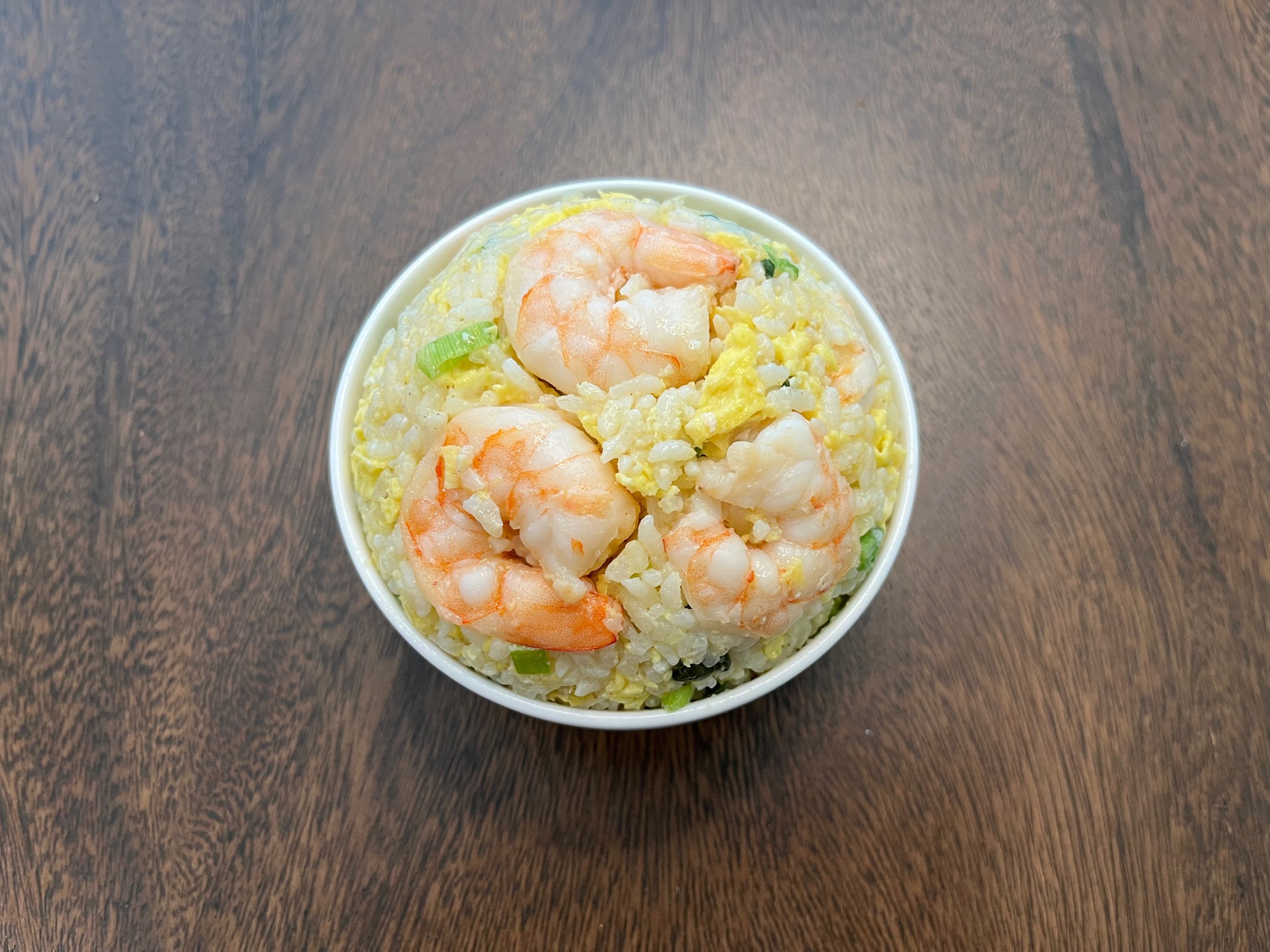Yangzhou Fried Rice

揚州炒飯 (Yangzhou Chao Fan)
Yangzhou fried rice is an iconic Chinese dish, served in restaurants around the world. [1] Purportedly invented by governor, poet, and artist Yi Bingshou (伊秉綬)[2] and named after his home city, Yangzhou fried rice is a mildly flavored dish which contains a multitude of varied ingredients and highlights the region’s culinary emphasis on knifework. The traditional list of ingredients featured in this fried rice is long and diverse—eggs, pork, fresh vegetables, bamboo, scallions, shrimp, and even sea cucumber and crab. That a recipe from the pre-industrial era contains so many fresh ingredients from different parts of China speaks to the city of Yangzhou’s historic wealth, its merchants plying the Grand Canal from Beijing to Hangzhou. [3] Fortunately for us, modern supermarkets collect many of these ingredients in one convenient place, making Yangzhou fried rice an easy dish to make at home! Fried rice is a great meal prep, keeping well in the refrigerator for several days. This recipe can also be adapted to suit a wide range of ingredients.
Ingredients
6 cups cooked rice
4 eggs
8 oz Chinese sausage or cured Chinese ham, diced
8 oz shrimp, chopped
5 oz bamboo shoots, diced
1 cup green peas
2 carrots, diced
4 scallions, chopped
½ tsp white pepper
Vegetable oil
Salt to taste
Fried rice is generally made from leftover rice, and we’ll be using six cups of cooked rice for this recipe. If you are making rice specifically for this recipe, 2 cups of uncooked rice will make about 6 cups of cooked rice. Make the rice on the drier side, to emulate leftover rice, and be sure the rice has had the chance to cool before using it in the fried rice. Otherwise, the freshly cooked rice will bring too much moisture to the dish, resulting in an unpleasant and mushy texture.
There are a lot of chopped ingredients in this dish, so let’s begin by doing some mise en place. We want all of the ingredients in the final fried rice to be about the same size, ½ inch cubes. Dice the Chinese sausage or ham, bamboo shoots, and carrots, and set aside in separate work bowls. Chop the shrimp into ½ inch pieces, and finely chop the scallions, setting those aside as well.
While fried rice is traditionally made all at once in a wok, we will not be able to replicate the high heat of a wok burner on a standard stovetop. Instead, we will use the standard approach when putting together large stir-fries at home—cooking ingredients in stages and combining at the end. We will be doing three rounds of stir-frying for this fried rice; first the proteins, second the vegetables, and third the eggs and rice.
Round 1: pork and shrimp. Begin by adding the diced sausage or cured ham to a cold skillet, and turn the heat to low. Both of these products contain a fair amount of fat, which can be rendered to cook both itself and the shrimp. The rendered pork fat also will lend a wonderful flavor to the rice. After about 3 minutes, the pork will have rendered much of its fat. Turn the heat up to high and add the chopped shrimp to the skillet. Fry the shrimp and sausage for 2 minutes, tossing occasionally, until the shrimp is just cooked through. At that point, remove the shrimp and sausage from the heat. I like to use a large bowl to hold all of the cooked ingredients until they are ready to go back into the skillet.
Round 2: vegetables. If there isn’t enough fat left in the skillet to cook with, add a bit of vegetable oil. Return the skillet to high heat, and add the diced carrots and bamboo shoots to the skillet, together with half of the chopped scallions. Fry this vegetable mixture for 4 minutes, tossing occasionally, until the carrots have softened. Then add the peas to the skillet, and stir together until the peas have warmed through, about 1 minute. Remove the vegetables from the heat, placing them in the same bowl as the shrimp and sausage.
Round 3: eggs and rice. Once again, if there isn’t enough fat left, add a bit more vegetable oil, and return the skillet to the heat. Beat the 4 eggs together, and pour the beaten eggs into the skillet. There are a couple of ways to break up eggs for fried rice, but the method we will use today is designed to produce smaller, more tender bits of egg. After the eggs have been in the skillet for 1 minute and before they set, add the cooked rice straight into the eggs. Press the rice into the egg mixture with a spatula and then begin breaking the rice up. This motion will simultaneously break up the egg curds. Toss the rice with the eggs until the rice has warmed through, the grains have separated, and the strands of egg have cooked. This should all take about 2 minutes.
Once the eggs are done, turn the heat down to low to prevent the rice from burning. Add the vegetables, sausage, and shrimp back to the skillet, and toss together until all of the ingredients are warm and well distributed, about 2 minutes. Stir in the reserved chopped scallions, season to taste with salt and white pepper, and serve.
Substitutions
You can use either white or brown rice in this recipe, as long as it is relatively dry. Short and medium-grain rice varieties work best, but long-grained rice can also be used.
Char siu, Chinese barbeque pork, is often used in place of the sausage in this fried rice. If you can’t find Chinese sausage or cured ham, the closest Western substitute is either thick-cut bacon or pancetta. Some preparations of Yangzhou fried rice add some diced chicken to the protein mix. The most traditional versions of this dish include sea cucumber and crab meat, with dried scallops featured in some preparations. Other vegetables can also be used, such as corn and shiitake mushrooms.
[1] In Chinese restaurants in the West, Yangzhou fried rice is often referred to as “special fried rice” or “house fried rice.”
[2] Yi Bingshou lived from 1754 to 1815, and served as governor of both Huizhou and Yangzhou. He is best known as a calligrapher, but also painted landscapes. A collection of his landscape paintings is in the collection of the Met in New York City.
[3] The Grand Canal (大運河) is both the oldest and the longest man-made waterway in the world. Over 1,000 miles long and with stretches dating to the 5th century BCE, the canal connected the two great rivers of China, the Yellow and Yangtze, created a water route from Northern China to Southern China, and linked Beijing to the sea.
Recipe
Prep Time: 15 min Cook Time: 15 min Total Time: 30 min
Difficulty: 2/5
Heat Sources: 1 burner
Equipment: rice cooker (optional), skillet
Servings: 12
Ingredients
6 cups cooked rice
4 eggs
8 oz Chinese sausage or cured Chinese ham, diced
8 oz shrimp, chopped
5 oz bamboo shoots, diced
1 cup green peas
2 carrots, diced
4 scallions, chopped
½ tsp white pepper
Vegetable oil
Salt to taste
Instructions
1. Dice the Chinese sausage, bamboo shoots, and carrots into ½ inch cubes. Chop the shrimp into ½ inch pieces, and finely chop the scallions.
2. Add the diced sausage to a cold skillet. Cook over low heat for 3 minutes, until the sausage pieces have rendered much of their fat.
3. Turn the heat up to high, and add the chopped shrimp to the skillet. Fry the shrimp with the sausage for 2 minutes, tossing occasionally, until the shrimp is just cooked through. Remove the cooked sausage and shrimp from the skillet and set aside in a large bowl.
4. Add a bit of vegetable oil to the skillet if necessary, and add the carrots, bamboo shoots, and half of the scallions to the skillet. Fry for 4 minutes, tossing occasionally.
5. Add the peas to the skillet, and stir together for 1 minute until the peas are warmed through. Remove the cooked vegetables from the heat, placing the vegetable mixture in the same bowl as the sausage and shrimp.
6. Add 1 tbsp vegetable oil to the skillet, and let the oil come to temperature. Beat the 4 eggs. When the oil is hot, pour the eggs into the skillet.
7. After the eggs cook for 1 minute, add the cooked rice to the skillet. Break up the rice and press it into the skillet with a spatula, breaking up the eggs simultaneously. Toss the rice with the eggs until the rice has warmed through, the grains have separated, and the egg is evenly distributed, about 2 minutes.
8. Turn the heat to low and add the vegetable, sausage, and shrimp mixture back to the pan. Toss the ingredients with the rice until well combined and the other ingredients have warmed through, about 2 minutes. Stir in the reserved scallions, season with white pepper and salt to taste, and serve.
